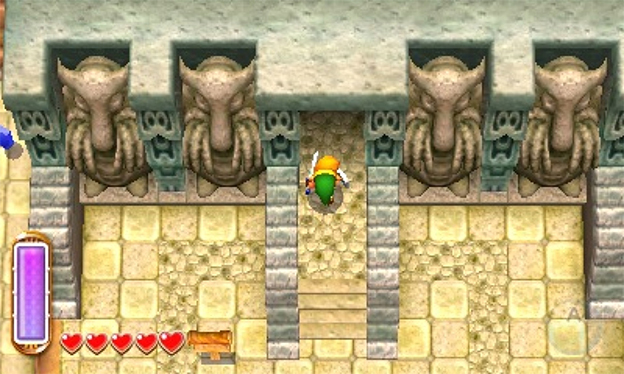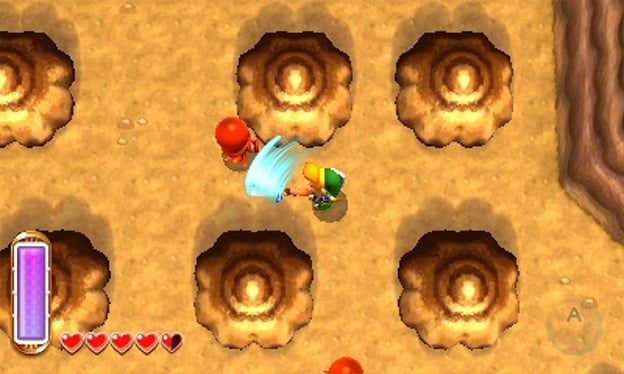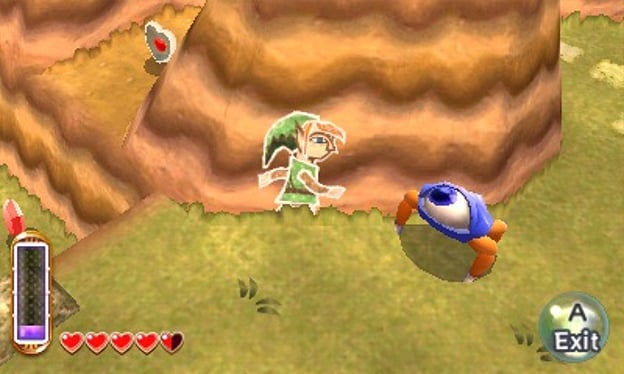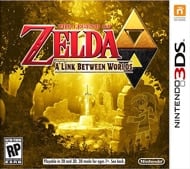A Link to Fun
Thanks to modern 3D graphics, it’s been a while since we’ve seen a traditional top-down Zelda game. The Legend of Zelda: A Link Between Worlds on the 3DS has given Nintendo the opportunity to resurrect that perspective while giving us some modern twists, such as adding verticality to dungeon puzzles and allowing Link to merge with walls. On top of that, this game lays the foundation for the future of the series, providing players with a mostly open world to explore in a non-linear fashion.
A Link Between Worlds is set in the same world as the Super Nintendo classic game A Link to the Past but several generations later. While the game’s overworld has a similar layout, all the dungeons are different, as is the story and most of the characters. This game’s Link is a blacksmith’s apprentice, albeit a lazy and somewhat incompetent one, who becomes entangled in a struggle to save Hyrule when an evil character assaults Hyrule castle and begins turning important local figures into paintings.
Several dungeons later, Link discovers that his land’s troubles stem from Lorule, an alternate version of Hyrule that resembles (but is not the same place as) the alternate Dark World found in A Link to the Past . This is where the game opens up, as Link needs to rescue seven sages, but can do so in whatever order he wishes. It’s the first largely non-linear game since the original The Legend of Zelda , setting the stage for the (reportedly less linear than usual) next console Zelda.
Supporting this non-linearity is A Link Between Worlds’ item system. Instead of finding puzzle-solving tools inside dungeons, Link rents (and later outright buys) them from a friendly sales-rabbit who has set up shop in Link’s home. All but one of the tools is available from the moment the store opens, giving the player complete control over their own loadout.
Renting items is cheap, but they will all be taken back if the player dies. Buying the items means they’re forever in the player’s inventory, but their high prices mean it will take some time to permanently acquire them all. There’s a nice variety of tools available, from the ever-helpful bow and arrow to various magic wands that both attack foes and solve environmental puzzles.

On top of his arsenal of weapons and tools, Link gains the ability to merge with walls early on, becoming a two-dimensional cave painting. This ability is used in various clever ways throughout the game, allowing Link to travel through cracks in walls, hide from enemies, and cross chasms. It’s the basis for a number of tricky puzzles as well, although barriers have been erected all over the place to prevent the player from breaking the game via wall-merging.
Tool use and wall-merging are governed by an energy bar that regenerates quickly when it’s not in use. The best news about the bar is that it replaces consumable items, so Link no longer has to run around collecting bombs, arrows, etc. In general, the bar is quite generous, allowing for plentiful tool use but punishing the player for mindlessly spamming buttons. The only time it requires careful management is while wall-merging, as Link will pop back out of the wall when the bar runs out.

The overworld is a fun place to explore and search for treasure, but the meat of A Link Between Worlds is found in its dungeons. Most dungeons only require one or two of Link’s tools, but having a full arsenal gives extra puzzle solving and monster-bashing options. The first few dungeons are easy, even a bit boring, for Zelda veterans, but once the game opens up and Link tackles the dungeons of Lorule, they become increasingly interesting and elaborate. Many of the later dungeons have puzzles that span multiple rooms and require some out-of-the-box thinking. The puzzles are satisfying but generally not too frustrating—and if the player gets really stuck, hint ghosts can be paid off with Play Coins to offer advice.
Fighting the dungeon bosses isn’t quite as interesting as solving the puzzles of the dungeons themselves, though beating some of them involves amusing uses of Link’s tools and wall-merging abilities. It would have been nice to see the bosses stick a bit less slavishly to the “use the tool that you used in the rest of this dungeon” formula. Still, most of these fights are fairly novel. The designers thankfully avoided boss-fight mechanics that have become overly cliché for the series, such as throwing a bomb into a large creature’s gaping mouth.
The particular top-down view chosen for this game has pluses and minuses. On the upside, the perspective and design does a stellar job of presenting the game’s puzzles. The system’s 3D function is used to great effect for vertically oriented puzzles, especially in the Tower of Hera. On the other hand, one of the best aspects of the “Toon Link” graphical style has been the expressiveness of the characters, particularly Link. In this game, we almost never see anything but his hat and bangs. There are occasional close-up scenes, but even then, the game’s presentation puts too much emotional distance between the characters and the players.
Music is another matter, as the game is filled with delightful remixes of classic Zelda tunes, particularly those that originated in A Link to the Past . The game’s sound definitely pushes all the right nostalgia buttons, but it will be appealing to new players as well.

There’s a small bit of connectivity built into the game. StreetPassing another Zelda player adds a Shadow Link battle into a random spot in the game. Players can hunt down rival Shadow Links, earning money and in-game achievements for defeating them. Don’t get too excited about the phrase “Shadow Link,” though. Your enemies don’t mirror your moves, and Link is a pushover without a human intelligence controlling him. The prize money is nice early on, but once you’ve bought all the tools, there’s very little need to collect coin in the game. It’s a fun side activity, but the game would be just as good without it.
There are plenty of other side activities and mini-games available, from Cucco dodging to Octorok baseball to a tower full of arena battles. The real side attraction, however, is simply hunting for treasures in a world bristling with secrets. Players will especially want to partake in a baby creature hunt that spans both worlds and results in upgrades for Link’s tools. Make sure to start this hunt as soon as you can by disobeying warnings on signposts like the naughty little boy Link is.
A Link Between Worlds captures plenty of that old Zelda magic with its excellent dungeon design and gameplay-first formula. Series fans will not be disappointed, although it may not deviate from formula quite enough for some. In my estimation, the developers stuck to the right parts of series formula while innovating in important areas, such as non-linearity and user-friendly interface decisions. This is yet another entry in a string of great 3DS games this year, making that device one of the best gaming investments out there.
RATING OUT OF 5 RATING DESCRIPTION 3.9 Graphics
While they’re great for presenting puzzles, the top-down visuals remove the player emotionally from the game. 4.4 Control
The game is easy to control and the interface is quite user-friendly. 4.5 Music / Sound FX / Voice Acting
Delightful remixes of classic Zelda tunes liven up gameplay. 4.5 Play Value
Plenty of dungeons, little required filler, and lots of secrets to discover. 4.4 Overall Rating – Great
Not an average. See Rating legend below for a final score breakdown.
| Review Rating Legend | |||
|---|---|---|---|
| 0.1 – 1.9 = Avoid | 2.5 – 2.9 = Average | 3.5 – 3.9 = Good | 4.5 – 4.9 = Must Buy |
| 2.0 – 2.4 = Poor | 3.0 – 3.4 = Fair | 4.0 – 4.4 = Great | 5.0 = The Best |
Game Features:
